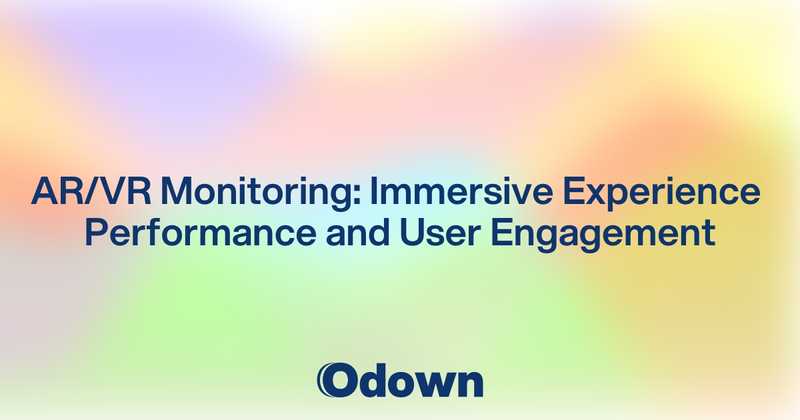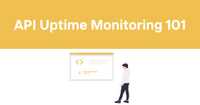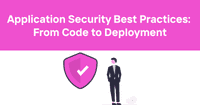AR/VR Monitoring: Immersive Experience Performance and User Engagement
Your VR training simulation just caused three users to experience motion sickness during a critical safety exercise. Your AR shopping app is dropping tracking accuracy, making virtual furniture appear to float in mid-air instead of sitting on the floor. Your metaverse platform is experiencing frame rate drops that break immersion and force users to log out. These aren't just performance problems---they're immersion-breaking failures that destroy the entire value proposition of AR and VR applications.
Traditional application monitoring focuses on response times and error rates, but immersive experiences require entirely different metrics. A 100ms delay that's barely noticeable in a web application can cause nausea and disorientation in VR. Frame rate drops that would be minor annoyances in traditional apps can make AR applications completely unusable.
AR and VR monitoring must account for human perception, spatial computing, and real-time rendering requirements that don't exist in traditional applications. The goal isn't just functional correctness---it's maintaining the illusion of presence that makes immersive experiences valuable.
Advanced monitoring platforms adapt to immersive computing requirements by tracking human-centered metrics alongside technical performance indicators. But effective AR/VR monitoring requires understanding perception psychology, spatial computing constraints, and the unique ways that technical problems manifest in immersive environments.
Immersive Experience Metrics: Frame Rate, Latency, and Motion Sickness Prevention
Immersive experiences require consistent performance that meets human perceptual requirements, making traditional performance metrics insufficient for AR/VR applications.
Frame Rate and Rendering Performance
VR applications must maintain consistent frame rates to prevent motion sickness and maintain immersion:
Frame rate consistency monitoring tracks not just average frame rates but frame time variance that causes judder and breaks immersion. VR applications typically require 90+ FPS with minimal variance to prevent discomfort.
Dropped frame detection identifies when rendering systems can't keep up with required refresh rates. Even brief frame drops can cause noticeable stuttering that destroys presence in VR environments.
Foveated rendering optimization monitoring tracks how effectively systems reduce rendering load by decreasing quality in peripheral vision areas. Foveated rendering can improve performance without affecting perceived quality.
Motion-to-Photon Latency
The delay between user movement and visual response affects immersion and can cause motion sickness:
Head tracking latency measurement monitors the complete pipeline from head movement detection through rendering to display update. Total latency must remain below 20ms to maintain convincing immersion.
Controller input latency tracking measures delays between user actions and system responses. High input latency makes interactions feel sluggish and reduces user engagement.
Predictive tracking accuracy monitoring evaluates how well systems anticipate user movement to compensate for inherent processing delays. Good prediction reduces perceived latency and improves user experience.
Spatial Accuracy and Tracking Quality
AR and VR applications depend on accurate spatial tracking that can fail in subtle ways:
6DOF tracking precision monitoring measures how accurately systems track position and orientation changes. Tracking drift accumulates over time and can cause virtual objects to appear misaligned with reality.
World mapping quality assessment for AR applications tracks how well systems understand real-world geometry. Poor world mapping causes virtual objects to appear in physically impossible locations.
Occlusion handling monitoring ensures that virtual objects correctly hide behind real-world objects in AR applications. Incorrect occlusion breaks the illusion that virtual and real objects coexist.
AR/VR Hardware Monitoring: Headsets, Controllers, and Tracking Systems
Immersive computing depends on sophisticated hardware that requires specialized monitoring approaches to ensure optimal performance and prevent user discomfort.
Headset Performance and Health
VR and AR headsets contain complex systems that affect user experience and safety:
Display calibration monitoring tracks color accuracy, brightness uniformity, and pixel persistence across headset displays. Display inconsistencies can cause eye strain and reduce immersion quality.
Thermal management monitoring prevents headsets from overheating during extended use. Excessive heat can cause performance throttling and user discomfort that limits session length.
Battery life prediction for wireless headsets helps users plan sessions and avoid unexpected shutdowns during critical activities. Battery monitoring also tracks charging system health and optimization opportunities.
Controller and Input Device Monitoring
Hand controllers and other input devices require precise tracking and responsive feedback:
Controller tracking accuracy monitoring measures how precisely systems track hand and finger movements. Tracking errors cause virtual hands to behave unnaturally and break immersion.
Haptic feedback system monitoring ensures that tactile responses remain synchronized with visual and audio cues. Delayed or inconsistent haptic feedback reduces the sense of presence and interaction quality.
Input device battery management tracks power consumption and charging patterns for wireless controllers. Battery failures during immersive sessions can be particularly disruptive to user experience.
Environmental Sensor Integration
AR/VR systems use multiple sensors that must work together to create coherent experiences:
Camera system monitoring for AR applications tracks image quality, exposure settings, and calibration accuracy. Camera problems directly affect the quality of mixed reality overlays.
IMU sensor fusion monitoring ensures that accelerometers, gyroscopes, and magnetometers provide consistent orientation tracking. Sensor fusion errors can cause drift and tracking instability.
Room-scale tracking system monitoring covers external sensors and base stations that enable large-area VR experiences. Tracking system failures can cause safety issues when users can't see real-world obstacles.
Content Delivery Monitoring for AR/VR: 3D Assets and Real-Time Streaming
Immersive applications require sophisticated content delivery systems that can stream large 3D assets and maintain real-time performance across various network conditions.
3D Asset Streaming and Optimization
AR/VR applications often require streaming large 3D models and textures in real-time:
Level-of-detail optimization monitoring tracks how effectively systems adjust model complexity based on viewing distance and performance requirements. Poor LOD management can cause performance problems or visual popping.
Texture streaming performance measures how quickly high-resolution textures load and display. Slow texture streaming causes blurry or missing textures that break immersion.
Mesh compression and delivery monitoring tracks how efficiently 3D geometry data is compressed and transmitted. Large mesh files can cause loading delays that interrupt immersive experiences.
Real-Time Multi-User Synchronization
Shared AR/VR experiences require real-time synchronization between multiple users:
Avatar synchronization monitoring tracks how accurately systems represent other users' movements and actions. Poor synchronization makes other users appear to lag or move unnaturally.
Shared object state management monitoring ensures that interactive objects behave consistently across all users' views. State desynchronization can cause objects to appear different to different users.
Network topology optimization for VR monitors how effectively systems handle peer-to-peer or server-based networking for multi-user experiences. Network architecture affects both performance and scalability.
Adaptive Quality Management
AR/VR systems must adapt quality settings based on performance and network conditions:
Dynamic quality scaling monitoring tracks how systems adjust rendering quality, resolution, and frame rate to maintain performance targets. Quality scaling should be transparent to users.
Bandwidth adaptation monitoring measures how applications adjust content delivery based on available network bandwidth. Poor bandwidth adaptation can cause loading delays or quality degradation.
Progressive content loading monitoring tracks how applications prioritize loading essential content first while streaming additional details in the background. Poor loading prioritization can delay session start times.
User Experience Analytics: Engagement, Interaction Patterns, and Accessibility
AR/VR monitoring must go beyond technical metrics to understand how users actually experience and interact with immersive content.
User Engagement and Retention Metrics
Immersive experiences require different engagement metrics than traditional applications:
Session duration and frequency tracking measures how long and how often users engage with AR/VR content. Short sessions might indicate comfort issues or poor user experience.
Interaction depth analysis tracks how extensively users explore available features and content. Shallow interaction patterns might indicate usability problems or insufficient motivation.
Return rate monitoring measures whether users come back to AR/VR applications after initial experiences. Low return rates often indicate fundamental experience problems.
Comfort and Accessibility Monitoring
AR/VR applications must accommodate users with different abilities and comfort levels:
Motion sickness incident tracking monitors user reports and behavior patterns that indicate discomfort. High discomfort rates require immediate attention to prevent negative user experiences.
Accessibility compliance monitoring ensures that AR/VR applications work for users with disabilities. Vision, hearing, and mobility limitations require specialized accommodation strategies.
Ergonomic usage pattern analysis tracks how users physically interact with AR/VR systems to identify potential comfort or safety issues. Poor ergonomics can cause physical strain and limit adoption.
Behavioral Analytics and Optimization
Understanding user behavior in immersive environments helps optimize content and interactions:
Gaze tracking and attention analysis shows where users look and what captures their attention in AR/VR environments. Attention patterns help optimize content placement and interface design.
Gesture and interaction pattern analysis tracks how users naturally try to interact with virtual objects. Understanding natural interaction patterns helps improve interface design.
Spatial movement analysis shows how users move through virtual or augmented spaces. Movement patterns help optimize environment design and identify navigation problems.
AR/VR monitoring builds on traditional performance monitoring while addressing human perceptual requirements. Quantum computing monitoring concepts provide relevant insights for monitoring complex systems with strict performance requirements.
Ready to implement comprehensive AR/VR monitoring that ensures optimal immersive experiences? Use Odown and build monitoring capabilities that track both technical performance and human-centered metrics for successful AR/VR applications.



